Study on the Formation Mechanism of Oil Sludge in Polyol Esters in Presence of High-Temperature Antioxidant N-Phenyl-α-naphthylamine
Abstract
1. Introduction
2. Experimental Section
2.1. Materials
2.2. Oil Sludge Acquisition
2.3. Measurements and Characterizations
3. Results and Discussion
3.1. High-Temperature Antioxidation Behavior
3.2. FT-IR Analysis
3.3. TGA
3.4. XPS Analysis
3.5. The Influence of Metal Content on the Formation of Sludge and GPC Analysis
3.6. MALDI-TOF MS Analysis
3.7. Sludge Formation Mechanism
4. Conclusions
- The polyol ester PE451 did not generate sludge under various elevated temperatures. In contrast, the addition of PANA to PE451 led to sludge formation after oxidation at temperatures above 180 °C for 96 h, suggesting that the antioxidant itself can trigger sludge formation.
- Characterization of the sludge revealed that the sludge was derived from base oil derivatives and antioxidant derivatives, and that the sludge also contained small amounts of metal compounds.
- Metal elements were identified as an essential factor in sludge formation. In the absence of metals, PANA did not produce sludge under high-temperature oxidation conditions.
- The polymerization reaction of PANA under high temperatures is a critical factor for sludge formation. The trimerized products became insoluble in PE451 and contributed significantly to sludge deposition.
- Based on the mechanistic findings, sludge formation in polyol ester lubricants containing PANA can be mitigated by adding suitable metal ion scavengers, blending PANA with other antioxidants to reduce its dosage, or chemically modifying PANA with substituents such as alkyl chains or ester groups to improve the solubility of its polymerized products. These strategies provide practical guidance for developing more stable lubricants under high-temperature conditions.
Supplementary Materials
Author Contributions
Funding
Data Availability Statement
Conflicts of Interest
References
- Luo, J.; Liu, M.; Ma, L. Origin of Friction and the New Frictionless Technology—Superlubricity: Advancements and Future Outlook. Nano Energy 2021, 86, 106092. [Google Scholar] [CrossRef]
- Wang, Y.; Liang, Y.; Li, Y.; Rui, W.; He, J.; Zhao, M. Synthesis, Tribological Properties and Oxidative Stability of Polyol Esters Base Oils Containing Pentaerythritol Complex Esters. Tribol. Int. 2024, 195, 109618. [Google Scholar] [CrossRef]
- Alias, N.H.; Yunus, R.; Idris, A.; Omar, R. Effects of Additives on Oxidation Characteristics of Palm Oil-Based Trimethylolpropane Ester in Hydraulics Applications. Eur. J. Lipid Sci. Technol. 2009, 111, 368–375. [Google Scholar] [CrossRef]
- Komatsuzaki, S.; Homma, Y.; Itoh, Y.; Kawashima, K.; Iizuka, T. Polyol Esters as Hfc-134a Compressor Lubricants. Lubr. Eng. 1994, 50, 801–807. [Google Scholar]
- Mousavi, P.; Wang, D.; Grant, C.S.; Oxenham, W.; Hauser, P.J. Measuring Thermal Degradation of a Polyol Ester Lubricant in Liquid Phase. Ind. Eng. Chem. Res. 2005, 44, 5455–5464. [Google Scholar] [CrossRef]
- Duong, S.; Lamharess-Chlaft, N.; Sicard, M.; Raepsaet, B.; Galvez, M.E.; Da Costa, P. New Approach for Understanding the Oxidation Stability of Neopolyol Ester Lubricants Using a Small-Scale Oxidation Test Method. ACS Omega 2018, 3, 10449–10459. [Google Scholar] [CrossRef] [PubMed]
- Jin, Y.; Li, J.; Jia, D.; Tu, J.; Zhan, S.; Yang, T.; Duan, H. Online Infrared Spectra Analysis of Multi-Phenol Antioxidants in Ester Lubricant During Friction under High-Temperature Oxidation. Tribol. Int. 2022, 176, 107877. [Google Scholar] [CrossRef]
- Xia, D.; Wang, Y.; Liu, H.; Yan, J.; Lin, H.; Han, S. Research Progress of Antioxidant Additives for Lubricating Oils. Lubricants 2024, 12, 115. [Google Scholar] [CrossRef]
- Wu, Y.; Li, W.; Zhang, M.; Wang, X. Improvement of Oxidative Stability of Trimethylolpropane Trioleate Lubricant. Thermochim. Acta 2013, 569, 112–118. [Google Scholar] [CrossRef]
- Hao, L.; Yang, H.; Li, A.; Song, H.; He, J.; Liang, Y. Study on the High-Temperature Bearing Test and Thermal-Oxidative Process of Aviation Lubricating Oils. Lubr. Sci. 2025, 37, 264–275. [Google Scholar]
- Abdolkarim, S.; Ehsan, A.; Christopher, P.; Spiridon, S.; Blakey, S. Investigation of Aviation Lubricant Aging under Engine Representative Conditions. Tribol. Trans. 2021, 64, 501–512. [Google Scholar] [CrossRef]
- Zhang, X.; Huang, X.; Li, J.; Tang, Z.; Wang, J. Thermal Oxidation of Aviation Lubricating Oil: Mechanism, Influencing Factors, Evaluation Methods, and Antioxidants. Asia-Pac. J. Chem. Eng. 2024, 19, e3114. [Google Scholar]
- Sniegoski, P.J. Quantitative Tlc Analysis of Amine Antioxidants in High-Temperature Jet Engine Lubricants. J. Chromatogr. Sci. 1977, 15, 328–329. [Google Scholar] [CrossRef][Green Version]
- Yoshida, T.; Igarashi, J. Consumption of Antioxidant of Turbine Oil in Service Unit. Tribol. Trans. 1991, 34, 51–58. [Google Scholar] [CrossRef]
- Kunina, E.A.; Kuznetsov, V.G.; Novosartov, G.T.; Boiko, L.V. Composition of Sludge Formed in B-3v Synthetic Lubricating Oil. Chem. Technol. Fuels Oils 1980, 16, 770–773. [Google Scholar] [CrossRef]
- Liu, Z.; Wang, H.; Zhang, L.; Sun, D.; Cheng, L.; Pang, C. Composition and Degradation of Turbine Oil Sludge. J. Therm. Anal. Calorim. 2016, 125, 155–162. [Google Scholar] [CrossRef]
- Kauffman, R.E.; Feng, A.; Karasek, K.R. Coke Formation from Aircraft Turbine Engine Oils: Part I—Deposit Analysis and Development of Laboratory Oil Coking Test. Tribol. Trans. 2000, 43, 823–829. [Google Scholar]
- Lillywhite, J.R.F.; Sant, P.; Saville, S.B. Sludge Formation: Investigation of Sludge Formation in Gasoline Engines. Ind. Lubr. Tribol. 1990, 42, 4–10. [Google Scholar]
- Zeman, A.; Von Roenne, V.; Trebert, Y. Fate of Amine Antioxidants During Thermal Oxidative Ageing of Neopentylpolyl Ester Oils. J. Synth. Lubr. 1987, 4, 179–201. [Google Scholar] [CrossRef]
- ASTM D445; Standard Test Method for Kinematic Viscosity of Transparent and Opaque Liquids (and Calculation of Dynamic Viscosity). ASTM International: West Conshohocken, PA, USA, 2023.
- ASTM D2270; Standard Practice for Calculating Viscosity Index from Kinematic Viscosity at 40 °C and 100 °C. ASTM International: West Conshohocken, PA, USA, 2024.
- ASTM D5950; Standard Test Method for Pour Point of Petroleum Products (Automatic Tilt Method). ASTM International: West Conshohocken, PA, USA, 2020.
- ASTM D92; Standard Test Method for Flash and Fire Points by Cleveland Open Cup Tester. ASTM International: West Conshohocken, PA, USA, 2024.
- ASTM D974; Standard Test Method for Acid and Base Number by Color-Indicator Titration. ASTM International: West Conshohocken, PA, USA, 2014.
- NB/SH/T 0956-2017; Standard test method for kinematic viscosity of transparent and opaque liquids by automated Houillon viscometer. Petroleum Industry Press: Beijing, China, 2017.
- GB/T 7304-2014; Standard test method for acid number of petroleum products by potentiometric titration. Standardization Administration of China: Beijing, China; Standards Press of China: Beijing, China, 2014.
- Yao, T.; Zhang, N.; Zhang, M.; She, X.; Liao, X.; Shen, Y.; Gan, Z. Effect of Iron and Copper on the Thermal Oxidation Stability of Synthetic Hydrocarbon Aviation Lubricating Oil. Catal. Commun. 2021, 161, 106363. [Google Scholar] [CrossRef]
- Wu, N.; Zong, Z.-M.; Fei, Y.-W.; Ma, J.; Guo, F. Thermal Oxidation Stability of Poly-A-Olefin Lubricating Oil. Asia-Pac. J. Chem. Eng. 2017, 12, 813–817. [Google Scholar] [CrossRef]
- Chen, T.; Yang, S.; Ma, J.; Gao, H.; Xu, X.; Xie, F.; Cao, J.; Hu, J. Real-Time Oxidation and Coking Behavior of Ester Aviation Lubricating Oil in Aircraft Engines. Tribol. Int. 2024, 192, 109240. [Google Scholar] [CrossRef]
- Zhao, H.; Feng, J.; Zhu, J.; Yu, H.; Liu, Y.; Shi, P.; Wang, S.; Liu, S. Synthesis and Application of Highly Efficient Multifunctional Vegetable Oil Additives Derived from Biophenols. J. Clean. Prod. 2020, 242, 118274. [Google Scholar] [CrossRef]
- Cann, P.; Spikes, H. In-Contact Ir Spectroscopy of Hydrocarbon Lubricants. Tribol. Lett. 2005, 19, 289–297. [Google Scholar] [CrossRef]
- Zhang, L.; Cai, G.; Wang, Y.; Eli, W. Synthesis and Characterisation of Antioxidant-Modified Esters of Dipentaerythritol as Lubricating Base Oil. Lubr. Sci. 2013, 25, 329–337. [Google Scholar] [CrossRef]
- Hu, J.-Q.; Yang, S.-Z.; Zhang, J.-J.; Guo, L.; Xu, X. Synthesis and Anti-Oxidative Properties of Poly(Diphenylamine) Derivative as Lubricant Antioxidant. Pet. Chem. 2019, 59, 1037–1042. [Google Scholar]
- Faujdar, E.; Singh, R.K. Methyl Oleate Derived Multifunctional Additive for Polyol Based Lubricants. Wear 2021, 466–467, 203550. [Google Scholar] [CrossRef]
- Sun, X.; Liu, X.; Chen, Q.; Guo, P.; Bai, Y.; Zou, K.; Yi, M.; Yang, S.; Cai, M.; Zhou, F.; et al. Amino Acid-Based Ionic Liquids as Water-Ethylene Glycol Additives Towards Superior Lubricity and Corrosion Resistance. J. Mol. Liq. 2024, 401, 124706. [Google Scholar] [CrossRef]
- Shang, X.; Zhang, S.; Yang, H.; Li, S.; Hu, L. High Temperature Tribological Studies of Oil-Soluble Ionic Liquids as Extreme Pressure and Anti-Wear Additives for Ester Oils. J. Mol. Liq. 2025, 419, 126761. [Google Scholar] [CrossRef]
- Sienkiewicz-Gromiuk, J.; Rusinek, I.; Kurach, Ł.; Rzączyńska, Z. Thermal and Spectroscopic (Ir, Xps) Properties of Lanthanide(Iii) Benzene-1,3,5-Triacetate Complexes. J. Therm. Anal. Calorim. 2016, 126, 327–342. [Google Scholar] [CrossRef]
- Wang, J.; Zhuang, W.; Yan, T.; Liang, W.; Li, T.; Zhang, L.; Wei, X. Tribological Performances of Copper Perrhenate/Graphene Nanocomposite as Lubricating Additive under Various Temperatures. J. Ind. Eng. Chem. 2021, 100, 296–309. [Google Scholar] [CrossRef]
- Cao, M.; Wang, H.; Ji, S.; Zhao, Q.; Pollet, B.G.; Wang, R. Hollow Core-Shell Structured Cu2O@Cu1.8S Spheres as Novel Electrode for Enzyme Free Glucose Sensing. Mater. Sci. Eng. C 2019, 95, 174–182. [Google Scholar] [CrossRef] [PubMed]
- Fu, X.; Guo, S.; Wan, Y.; Zheng, C.; Li, Q.; Liu, B. Superlubricity of Tin Coating Using Glycerol with the Addition of Cu Nanoparticles. Tribol. Int. 2023, 181, 108327. [Google Scholar] [CrossRef]
- Zhao, Z.; Li, X.; Wang, J.; Lv, X.; Bin Wu, H. CeO2-Modified Cu Electrode for Efficient CO2 Electroreduction to Multi-Carbon Products. J. CO2 Util. 2021, 54, 101741. [Google Scholar] [CrossRef]
- Bartl, P.; Völkl, C. The Application of Matrix-Assisted Laser Desorption/Lonisation Time-of-Flight Mass Spectrometry (Maldi-Tof Ms) to the Analysis of Lubricants. Part 1. Polyol Ester Aviation Turbine Engine Oils. J. Synth. Lubr. 1998, 15, 83–96. [Google Scholar]
- Bartl, P.; Völkl, C.; Kaiser, M. The Application of Matrix-Assisted Laser Desorption/Ionisation Time-of-Flight Mass Spectrometry (Maldi-Tof Ms) to the Analysis of Lubricants. Part 2. Used Polyol Ester Aviation Turbine Engine Oils. J. Synth. Lubr. 1999, 16, 99–113. [Google Scholar]
- Smith, J.R.L.; Nagatomi, E.; Waddington, D.J. The Autoxidation of Simple Esters: Towards an Understanding of the Chemistry of Degradation of Polyol Esters Used as Lubricants. J. Jpn. Petr. Inst. 2003, 46, 1–14. [Google Scholar]
- Yao, T.; Zhang, N.; Hu, J.; Liao, X.; Shen, Y.; Gan, Z. Effect of Temperature on the Chemical Composition and Physicochemical Properties of Diester Aviation Lubrication Oil. Int. J. Chem. Eng. 2020, 2020, 8829206. [Google Scholar] [CrossRef]
- Bakunin, V.N.; Parenago, O.P. A Mechanism of Thermo-Oxidative Degradation of Polyol Ester Lubricants. J. Synth. Lubr. 1992, 9, 127–143. [Google Scholar]
- Qian, X.; Xiang, Y.; Shang, H.; Cheng, B.; Zhan, S.; Li, J. Thermal-Oxidation Mechanism of Dioctyl Adipate Base Oil. Friction 2016, 4, 29–38. [Google Scholar] [CrossRef]
- Bowman, D.F.; Middleton, B.S.; Ingold, K.U. Oxidation of Amines with Peroxy Radicals. I. N-Phenyl-2-Naphthylamine. J. Org. Chem. 1969, 34, 3456–3461. [Google Scholar] [CrossRef]
- Bridger, R.F. Kinetics of Inhibition of Hydrocarbon Autoxidation by 1, 1’-Bis (N-Phenyl-2-Naphthylamine). J. Org. Chem. 1971, 36, 1214–1216. [Google Scholar] [CrossRef]
- Jensen, R.K.; Korcek, S.; Zinbo, M.; Gerlock, J.L. Regeneration of Amine in Catalytic Inhibition of Oxidation. J. Org. Chem. 1995, 60, 5396–5400. [Google Scholar] [CrossRef]
- Aguilar, G.; Mazzamaro, G.; Rasberger, M. Oxidative Degradation and Stabilisation of Mineral Oil-Based Lubricants. In Chemistry and Technology of Lubricants; Mortier, R., Fox, M., Orszulik, S., Eds.; Springer: Dordrecht, The Netherlands, 2010; pp. 107–152. [Google Scholar]
- Wylde, J.J. Chapter 4—Naphthenate and Carboxylate Soap Treatment. In Flow Assurance; Wang, Q., Ed.; Gulf Professional Publishing: Houston, TX, USA, 2022; pp. 227–285. [Google Scholar]

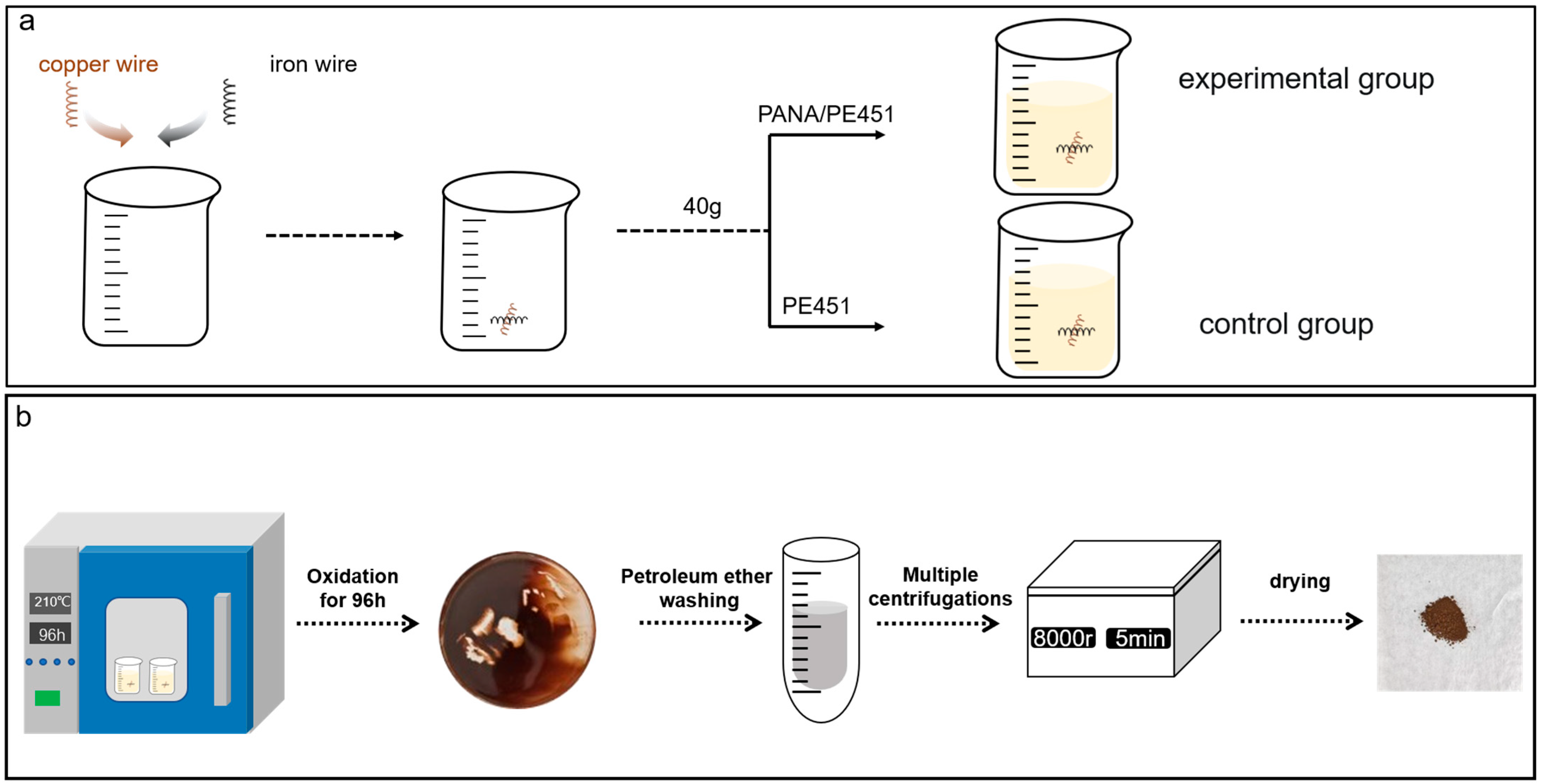


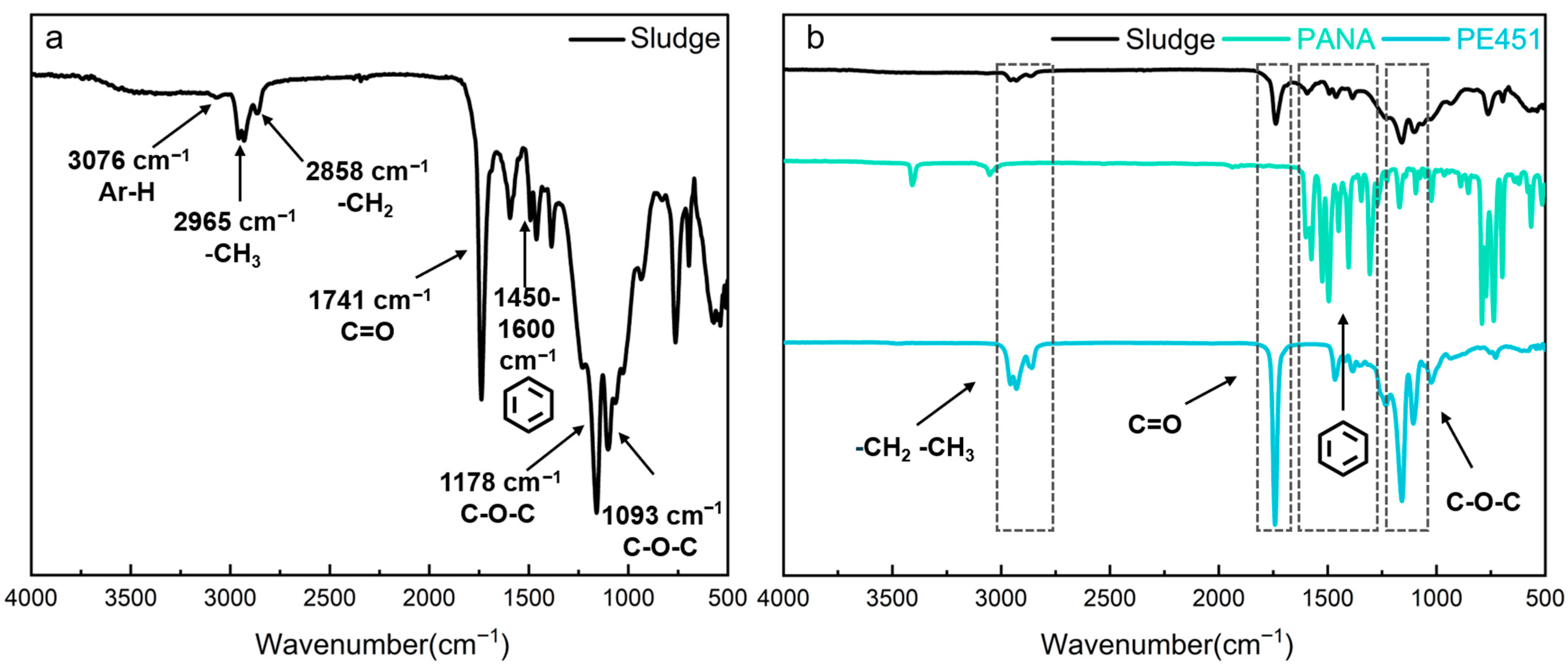
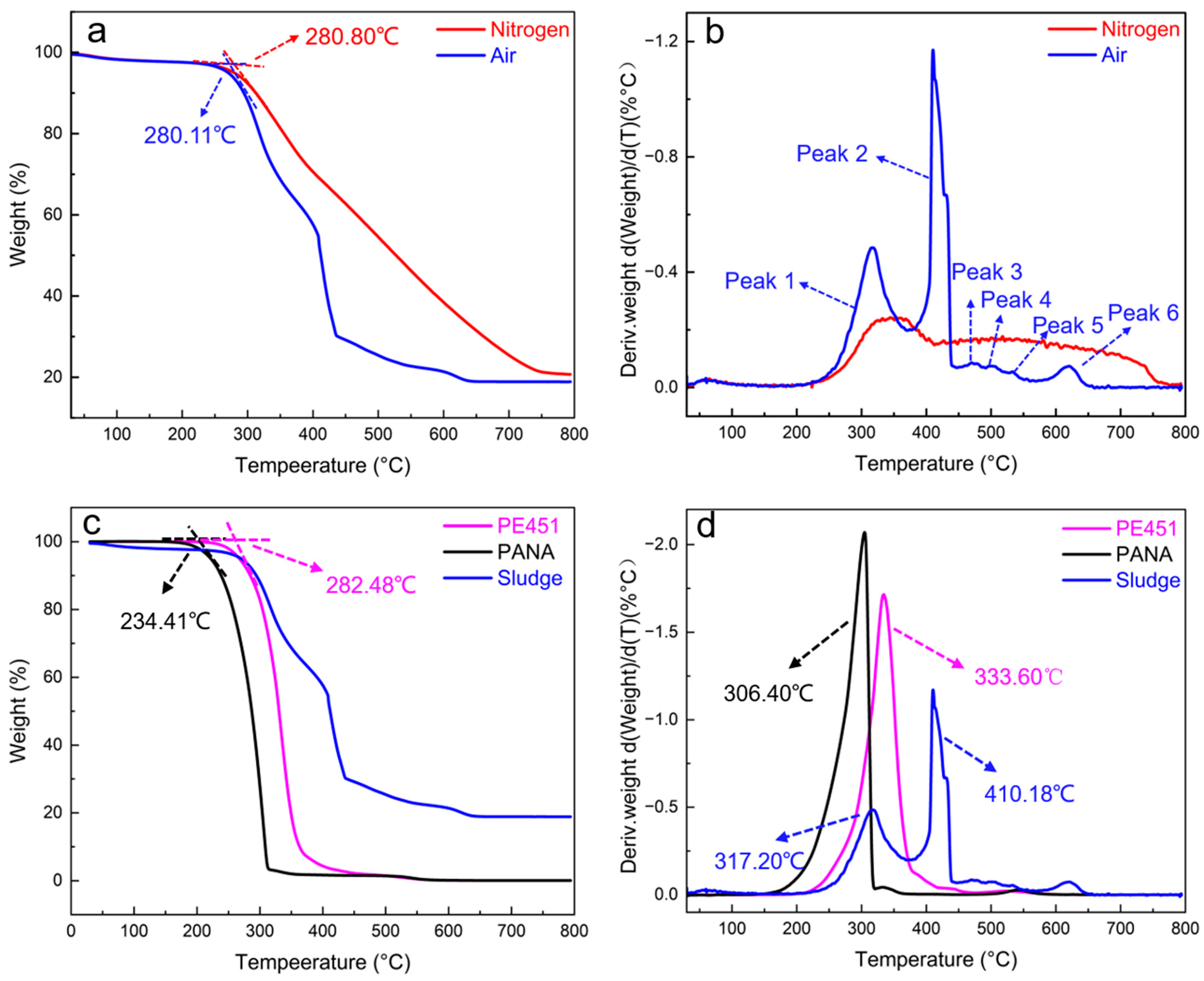
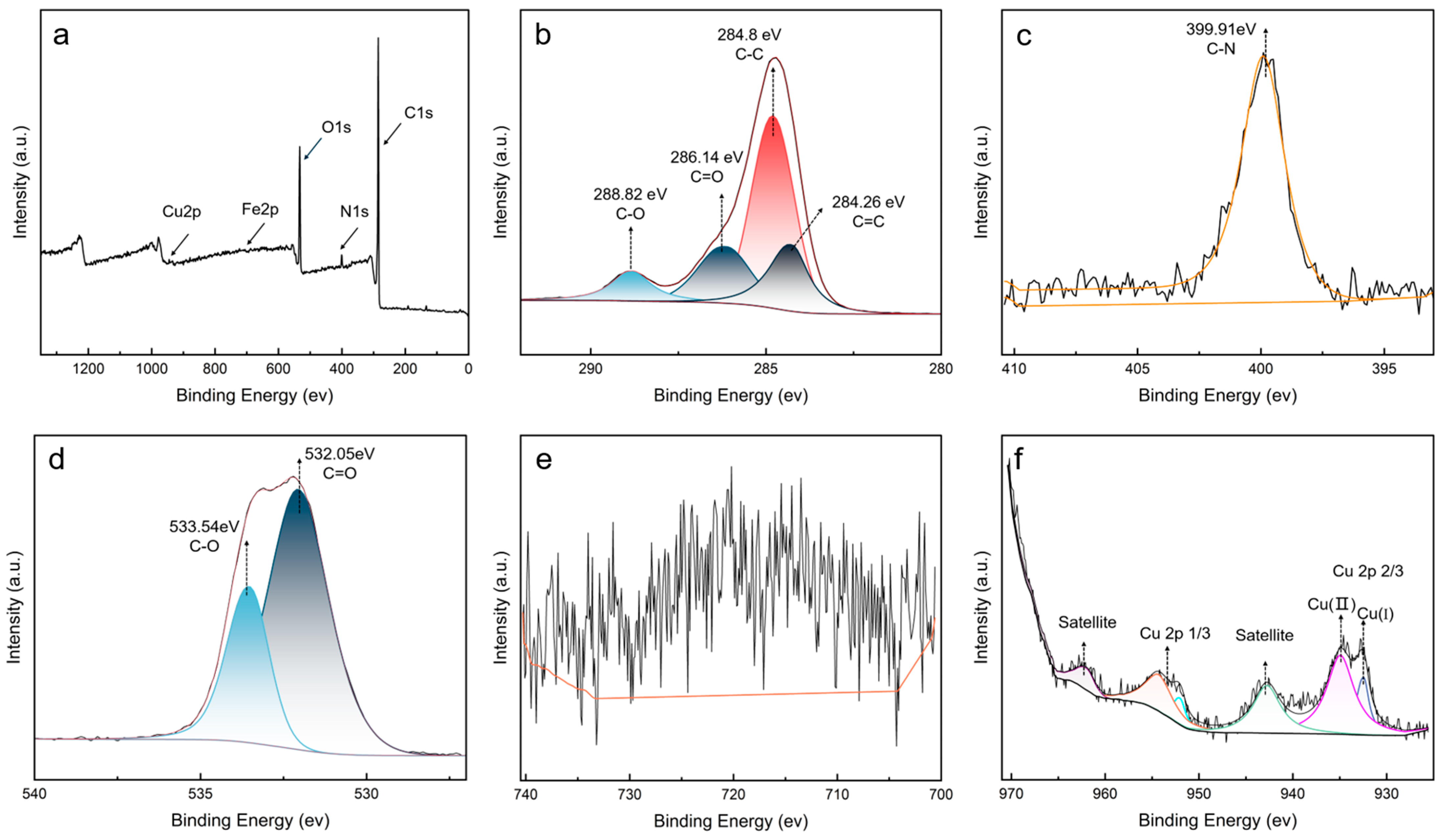
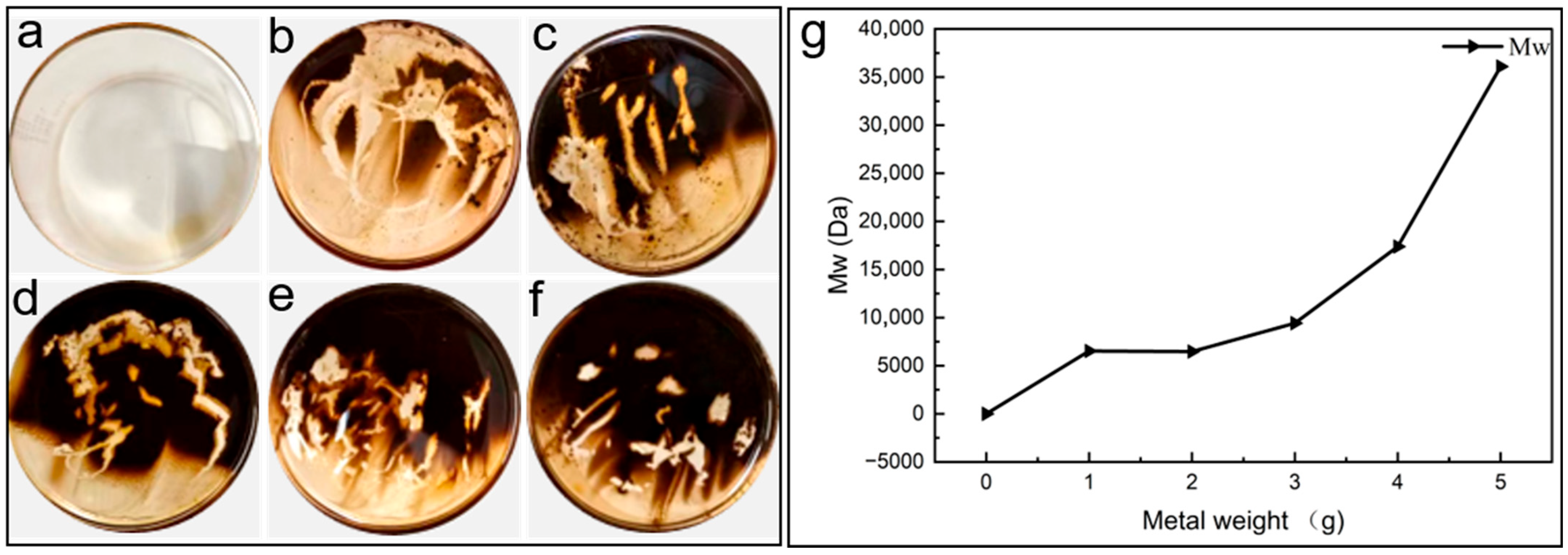

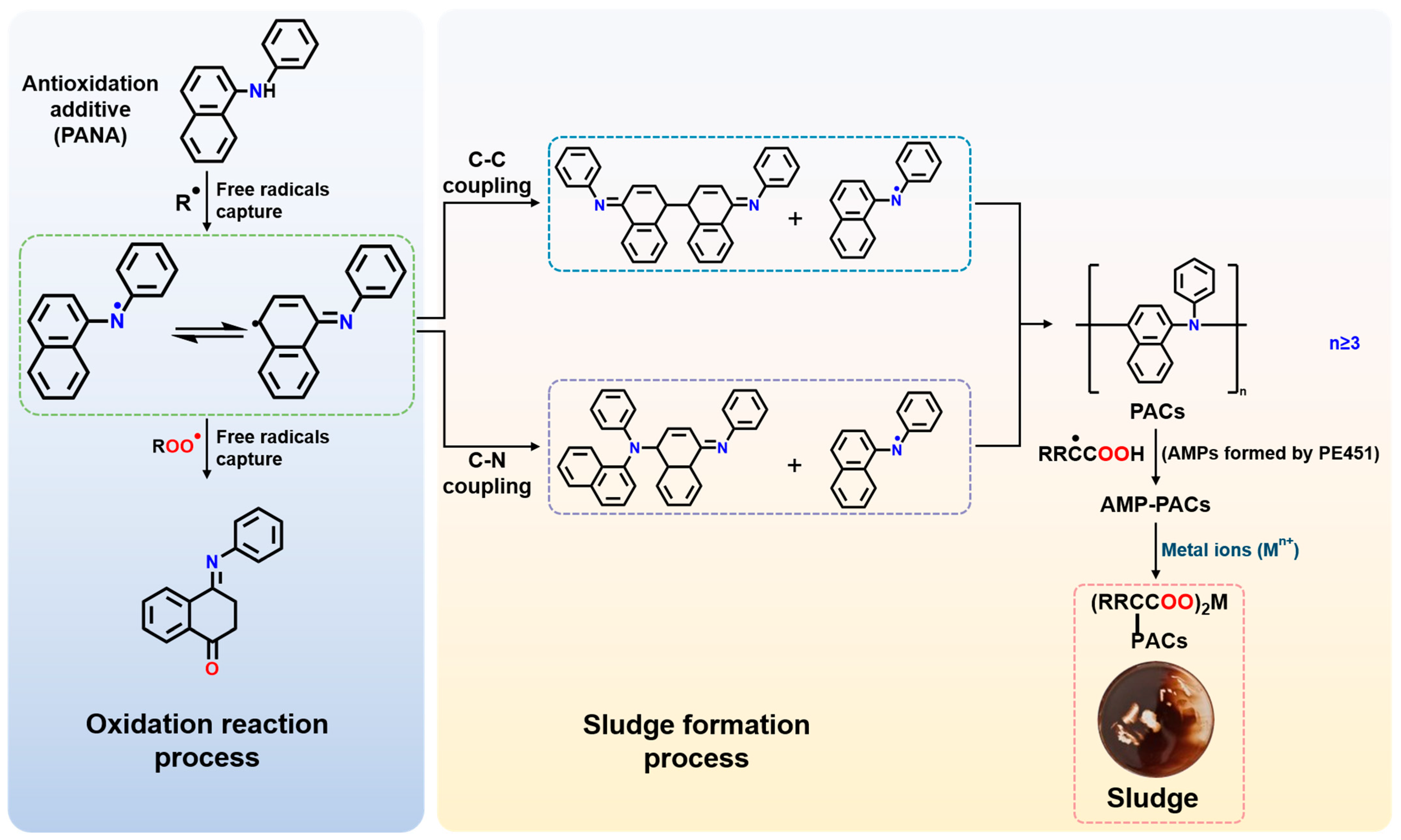
| Character | Value | Test Methods |
|---|---|---|
| Kinematic viscosity at 40 °C (cst) | 25 | ASTM D445 [20] |
| Kinematic viscosity at 100 °C (cst) | 5 | ASTM D445 [20] |
| Viscosity index (VI) | 130 | ASTM D2270 [21] |
| Pour point (°C) | −65 | ASTM D5950 [22] |
| Flash point (°C) | 255 | ASTM D92 [23] |
| Total acid number (mg KOH/g) | 0.05 | ASTM D974 [24] |
| Element | C | O | N | Cu | Fe |
|---|---|---|---|---|---|
| Atom/% | 78.48 | 17.57 | 3.26 | 0.38 | 0.31 |
| Contents | Results |
|---|---|
| Mw (Daltons) | 36,095 |
| Mz (Daltons) | 189,597 |
| Mn (Daltons) | 2044 |
| PDI | 17.658 |
| Mw_10%_low (Daltons) | 397 |
| Mw_10%_high (Daltons) | 210,632 |
Disclaimer/Publisher’s Note: The statements, opinions and data contained in all publications are solely those of the individual author(s) and contributor(s) and not of MDPI and/or the editor(s). MDPI and/or the editor(s) disclaim responsibility for any injury to people or property resulting from any ideas, methods, instructions or products referred to in the content. |
© 2025 by the authors. Licensee MDPI, Basel, Switzerland. This article is an open access article distributed under the terms and conditions of the Creative Commons Attribution (CC BY) license (https://creativecommons.org/licenses/by/4.0/).
Share and Cite
Cao, C.; Li, H.; Han, S.; Li, J. Study on the Formation Mechanism of Oil Sludge in Polyol Esters in Presence of High-Temperature Antioxidant N-Phenyl-α-naphthylamine. Lubricants 2025, 13, 403. https://doi.org/10.3390/lubricants13090403
Cao C, Li H, Han S, Li J. Study on the Formation Mechanism of Oil Sludge in Polyol Esters in Presence of High-Temperature Antioxidant N-Phenyl-α-naphthylamine. Lubricants. 2025; 13(9):403. https://doi.org/10.3390/lubricants13090403
Chicago/Turabian StyleCao, Cheng, Hanglin Li, Shichao Han, and Jiusheng Li. 2025. "Study on the Formation Mechanism of Oil Sludge in Polyol Esters in Presence of High-Temperature Antioxidant N-Phenyl-α-naphthylamine" Lubricants 13, no. 9: 403. https://doi.org/10.3390/lubricants13090403
APA StyleCao, C., Li, H., Han, S., & Li, J. (2025). Study on the Formation Mechanism of Oil Sludge in Polyol Esters in Presence of High-Temperature Antioxidant N-Phenyl-α-naphthylamine. Lubricants, 13(9), 403. https://doi.org/10.3390/lubricants13090403






